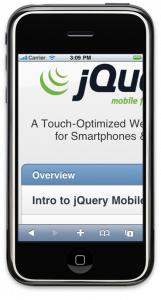| JQuery Mobile Beta 1 released |
| Written by Ian Elliot | |||
| Tuesday, 21 June 2011 | |||
|
The eagerly awaited JQuery Mobile has taken a big step towards its release - Beta 1 is here and provides expanded platform support, several major changes and a host minor tweaks and bug fixes.
Progress towards the release of JQuery Mobile hasn't been as rapid as anticipated and currently a date of "late summer" is the target with Beta 2 in about a month. Also jQuery Mobile 1.0 will require jQuery core 1.6 as a baseline - although later on it will support the two latest major versions of the core. JQuery Mobile supports a wide range of devices at one of three levels:
Having added WP7 support (A-grade) in Alpha 4 Beta 1 adds support for Blackberry 5 devices and Opera Mini. However both of these platforms get the put into the B grade category, along with Windows Phone 6.5, as they had issues with handling the Ajax-based navigation.
In general all the recent popular smartphone operating systems are A-Grade, although Android 3 is currently absent from the list. C-Grade includes Blackberry 4.x and devices that don't support media queries. There are some devices and platforms still to be tested including the Nokia S60 (targeted for Beta 2 release with A/B grade support)and Palm WebOS 3.0 (as test devices have not yet been forthcoming from Palm). Support for Samsung Bada, which doesn't currently have test devices or emulators, is expected to be fairly good and the project is considering dropping support for Meego in light of Nokia decision to relegate this platform to "experimental". Some of the key changes in Beta 1 are designed to make page transitions smoother and less jumpy. Two major items affecting the perceived smoothness - hiding the URL bar consistently and scrolling to the correct page position between transitions. The URL bar can now be hidden in both iOS and Android and a tweak that has been introduced in Beta 1 is a threshold value for how far down the user needs to scroll a page before their scroll position is restored. Other key changes are:
More information:Details of the platforms and devices that have been tested, details of the key changes, and the change log, plus links to download can be found on the jQuery Mobile Blog. See also Demos and Documentation
Related news:
<ASIN:1935182323> <ASIN:0596159773> <ASIN:0321647491> |
|||
| Last Updated ( Tuesday, 21 June 2011 ) |



